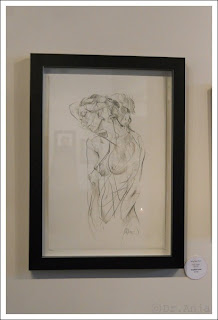 |
| interstices (installation view), 2011, mixed media |
“Space is not unlike a living organism. It can change or be changed, affect our moods, be mysterious and even ambiguous.” [From the City Hall Art Gallery exhibition booklet]
The current exhibition at the City Hall Art Gallery opens our senses for space by moving through the installation by kipjones. His intensive installation connects the gallery walls with long, wooden horizontal and vertical wands – and it feels like the room became alive.
 |
| interstices (installation view), 2011, mixed media |
In particular the walls seems to breath and move because their surface was furnished with organic, round shapes from which the lines reach into the space. The title “Interstice” refers to the space created between two objects and events; and that's what the exhibition is all about: The spatial environments between linear lines in the room, and the relationships between mental and physical spaces.
 |
| interstices (installation view), 2011, mixed media |
From the gallery's website:
linear gesture
A question of place as it relates to a uniquely defined space.
The modular long thin line gently emerging from an intersection,
a point, diverging,
re-focus,
into a long arcing waves,
defining boundaries, spatial edges.
A delineation of space, a dimensional gesture,
bound to the parameters of the temporal place,
a linear gesture
The experiential movement through the gallery leads to stunning perspectives of the installation that also illustrate movements itself by wavelike forms. We also seem to become a part of the space when we discover the installation from different angles, experience the interstices and become aware of interspace and spatial relations.
 |
| interstices (installation view), 2011, mixed media |
Facts:
kipjones
interstices: an intervening space
Ottawa City Hall Art Gallery
July 1 to August 21, 2011







